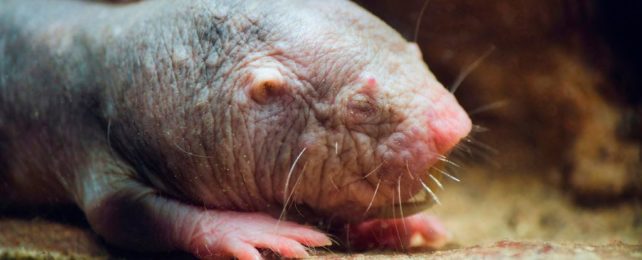Who would've thought a wrinkled-up, nearly blind sac of a mammal would be such a guru on ways to stay forever young?
That pink and flabby-skinned rodent we fondly call the naked mole-rat (Heterocephalus glaber) once again is teaching us something about the wonders of a long and healthy life, right up to the bitter end.
Like most other mammals, females of our own species are born with all the eggs they'll ever produce in their lifetimes. This supply then depletes over time (some through ovulation, most through dying), forcing fertility to decline with age.
But the naked mole-rat is, of course, exceptional.
This species is arguably the weirdest mammal out there, and not just because of its appearance. It breaks all the biological rules of mammal-ness: it doesn't have fur, it is essentially cold-blooded, and at times of oxygen deprivation, its metabolism reverts to a plant-like state.
"They're the longest-lived rodent, they almost never get cancer, they don't feel pain like other mammals, they live in underground colonies, and only the queen can have babies," marvels Miguel Brieño-Enríquez, who studies reproductive biology at the University of Pittsburgh.
"But to me, the most amazing thing is that they never stop having babies – they don't have a drop in fertility as they age. We want to understand how they do this."
Because as different as the naked mole-rat is, it's still similar enough to our own species that scientists are hopeful we can learn something from it.
Comparing naked mole-rats to mice, researchers found the former was born with an exceptionally large number of egg cells. After just eight days of life, the average female naked mole-rat had 1.5 million egg cells across both of her ovaries – 95 times more than a mouse of the same age.
What's more, that number of egg cells seemed to increase day by day from when she was born, "raising the possibility," researchers write, "that germ cells are actively dividing in the postnatal ovary" of the mole-rat to form egg cells, or oocytes.
"This finding is extraordinary," says endocrinologist Ned Place from Cornell University.
"It challenges the dogma that was established nearly 70 years ago, which stated female mammals are endowed with a finite number of eggs before or shortly after birth, without any additions being made to the ovarian reserve thereafter."
The researchers suspect that the lifelong fertility of naked mole-rats is an extraordinary adaptation to their long lives and unique social structure. Unlike bees, female naked mole-rats aren't born into their role as the main reproducer. Most colonies have a single queen – a dominant breeding female.
If the only breeding female in a group dies or is removed from the colony, other females need to be ready to step up and fight to the death to take her place. This is probably why even subordinate females in a colony, who are not actively breeding, appear to maintain abundant germ cells in their ovaries. Even at 10 years of age that still appears true.
What's more, these germ cells are ready to jump into action if necessary. When 3-year-old non-breeding females were taken from a colony and prompted into a reproductive state, the germ cells in their ovaries began to divide into oocytes, which can then be fertilized.
Further research is needed among older naked mole-rats to see whether the specialized cells in this species' ovaries show any signs of aging in the latter stages of their lives.
But there's reason to suspect that a high fertility rate is maintained for decades among naked mole-rats.
A study in 2018 found that naked mole-rats do not face an increased risk of death as they age. They seem to grow older in a way that differs from just about every other mammal we know of.
A female naked mole-rat can live 30 years or more, producing up to five litters a year, each of which contains about a dozen pups. Theoretically, if there is no loss in fertility over a female's lifetime, she could produce 2,000 offspring as queen.
If scientists can figure out how the naked mole-rat's ovaries continue to thrive in later life, then maybe that knowledge can help our own species.
Or at least that's what Brieño-Enríquez is hoping for. And his reasons go far beyond fertility.
"The ovary is more than just a baby factory," he says. "Ovary health influences cancer risk, heart health, and even lifespan. Better understanding of the ovary could help us find ways to improve overall health."
Let the near-blind, naked mole-rat be our guiding light.
The study was published in Nature Communications.
